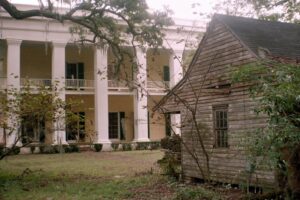As this new year flutters in, I began to ponder the seemingly self- perpetuating nature of ghost tales. Are ghosts merely echoes of someone who once was— a shadow of a memory? Why, like the solitary leaf clinging to the barren branches of a tree in winter, do they not just fall to the ground and be done with it? Popular mystery writer Sue Grafton argues that “Ghosts are present among us because we won’t let them go.”

Docent Beulah Davis, a strikingly tall black woman, has worked at Loyd Hall Plantation for many years and stands by her beliefs. .“When you see a figure or a shape moving on your side vision, and you know you’re the only person that’s supposed to be there that’s alive . . . that’s when I decided there was something for real.” To doubters, Davis cautions, “Wait until you have that personal experience and then you decide.” During her time at Loyd Hall in Chenyville, Louisiana, Davis has encountered all the plantation’s resident spirits: William Loyd, the original owner and reputed double agent during the Civil War; Harry Henry , the teenage Union Soldier who deserted his regiment, hid in the attic, and ultimately was shot and killed by Grandmother Loyd when she stumbled across the hapless soldier; and Sally, the family’s black nanny. It was rumored poor Sally was poisoned by persons unknown.

Sir Arthur C. Clarke, noted author of 2001, A Space Odyssey explains the existence of ghosts with a simple mathematical equation: “Behind every man is thirty ghosts, for that is the ratio by which the dead outnumber the living.”

Yet, in some cases, ghosts and haunted tales were “created” to serve a sinister purpose. Author Gladys –Marie Fry in her work Night Riders in Black Folk History purports that in the decades prior to the Civil War there was a “systematic exploitation of black folk beliefs and fears.” Fry writes that the slightest hint of a ghost lurking just beyond the boundaries of the plantation complex was a “dominant factor employed by wealthy planters to control slave movements.” Beulah Davis agrees that white masters and overseers used this scare technique to “keep rein over them.”

The idea of a ghostly figure that might reach out and grab you was also employed by Cajun parents to instill a little healthy fear in their children. The goal: to keep them safe from earthly predators, both wildlife and human. Cajun children were warned not to stray off the prescribed pathway or the Loup Garou, the Cajun werewolf, would snatch them up. Captain Jerome Dupré traces his ancestry back to the early Acadian settlers of Bayou Lafourche in the swamps of southern Louisiana. Dupré remembers being told by his parents, “If you go to Grandma’s house you stay on the path. If you wander off the Loup Garou is gonna bite you on the neck and you’re gonna spend the rest of your life dancing with the other werewolves on the bayou.” The name of the inventive parent who first spun the tale of the Loup Garou has been lost in the annals of folklore.

Could it be that easy to dismiss all ghosts and hauntings as just tall tales with a hidden agenda.?
William Maestri, former Catholic priest and moral theologian offers a challenging conundrum: “We are told by our culture that the only thing that matters is science which you can taste, see, touch, smell, and measure. That’s reality. Well, there is something in the human spirit that rebels against that. There are whole levels and dimensions of life that are simply going to come out whether we like it or not.”

And for many of us the mere possibility of a ghost sighting evokes a sense of excitement, a hope that there is indeed a still a link to a paranormal world where the long dead linger among us.
Ghost Roots
Leave a reply

